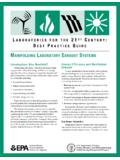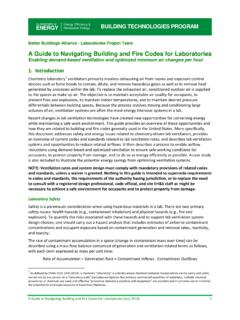Transcription of Best Practices Guide: Manifolding Laboratory Exhaust …
1 best Practices guide : Manifolding Laboratory Exhaust Systems MAY 2021. Introduction: Why Manifold? operation of safe, sustainable, high-performance laboratories. Manifolding Laboratory Exhaust in Laboratory buildings provides substantial energy and This guide has been updated to include further first-cost savings opportunities, compared technological advances, case studies, and changes with separately ducted systems with multiple in applicable codes and standards since the Exhaust fans. A manifolded system offers several original guide was published in 2007. additional benefits, including: Increased fume dilution. Energy Efficiency and Manifolded Exhaust Enhanced personnel safety. A basic, manifolded Exhaust system , with one or more primary fan(s) and a backup fan in Reduced cost of redundancy.
2 A common duct system , has higher energy Improved design flexibility for future efficiency than multiple, dedicated fans working revisions. independently. A manifolded Exhaust system Reduced cost of energy recovery. saves energy in the following ways: Reduced congestion in ceilings. 1. Reduces fan power, in part due to larger, Reduced cost of installation and operation. more efficient fans. 2. Provides an adjustable airflow system that Experience has shown that during Laboratory can modulate airflow needs in response to retrofit projects, manifolded Exhaust systems varying requirements ( Exhaust diversity). reduce construction costs and help avoid operational disruptions. These outcomes are 3. Requires less energy to disperse Exhaust especially likely when fume hood Exhaust can plumes due to increased dilution and be combined with general room Exhaust .
3 This momentum of effluent. guide is intended to provide relevant background 4. Increases energy recovery opportunities. for practical considerations when designing and operating Laboratory Exhaust systems. Even greater efficiency can be realized compared Locally applicable code and existing system with a basic manifolded arrangement when configurations must always be considered in the combined with other design best Practices , design process. including variable air volume fume hoods, multiple fans, and variable speed drives, This best practice guide is one in a series created which will be covered later in this guide and in by the International Institute of Sustainable referenced case studies. Variable speed drives and Laboratories (I2SL). Geared toward architects, variable volume fume hoods have increasingly engineers, and facilities managers, these guides become a design standard and should be assumed provide information about technologies and to be part of a typical approach unless there are Practices to use in the design, construction, and specific criteria preventing their use for a specific lab facility.
4 Contact I2SL: I2SL is dedicated to advancing sustainable laboratories globally. Manifolding Laboratory Exhaust Systems Fan Power Reduction Energy Recovery Opportunities Manifolded Exhaust systems reduce the number A manifolded Exhaust system increases the of fans compared with individual fume hood opportunity to recover energy contained in the Exhaust systems, and larger fans and fan motors conditioned air stream that is being exhausted from are inherently more efficient. For example, a small the laboratories because the Exhaust is centralized, fan system might have a fan efficiency of 50% and so energy recovery is possible at lower costs. a motor efficiency of 89%, while a larger fan system Numerous design and operational challenges can have a fan efficiency of 70% and a 94% motor are involved, including device corrosion, added efficiency.
5 Large ductwork can also have lower air- system pressure drops, increased maintenance pressure drop where duct velocity limits (typically costs, operational durability, and control used to limit noise generation) are reached, complexity, to name a few. Still, depending on resulting in lower friction rates compared with the geographical location, Exhaust -stream energy smaller ductwork (Varley, 2020). recovery, in the form of both heating and cooling energy, can be worth the design challenges and Adjustable Airflow maintenance issues. A manifolded Exhaust system can be designed to Chapter 514 of the International Mechanical Code accommodate varying fume hood airflow. Since it prohibits the use of energy recovery ventilation is unlikely that all of a facility's hoods will be fully systems, defined as air-to-air heat exchangers, in operational simultaneously, the inherent flexibility hazardous Exhaust systems.
6 However, air-to-water of a manifolded Exhaust system allows it to adjust systems, such as a run-around coil system , are its airflow rate accordingly to save energy. This allowed because supply and Exhaust air streams are concept, also known as diversity, can also be separated (Reilly et al., 2012). applied to sizing the manifolded Exhaust system , With a centralized manifold Exhaust system , to reduce manifold size and initial costs. However, run-around heat recovery can be implemented at caution is advised when considering a diversity much lower cost than with decentralized Exhaust factor; multiple issues, including future Laboratory systems. In fact, heat recovery from decentralized growth, must inform the decision. systems is almost never cost-effective because of the need for additional coils, controls, piping, and Exhaust Plume Dispersion so on.
7 Manifolded Exhaust systems have increased dilution, making Exhaust streams less hazardous. Basic Manifold Design In addition, combining numerous hood exhausts increases the momentum of this more dilute stream. Initial Considerations Consequently, a manifolded Exhaust stack disperses Despite the considerable benefits Laboratory a less hazardous stream into a plume more Exhaust manifolds can provide, lab design effectively than a single-fan-per- hood arrangement parameters will determine whether manifolds (Petersen et al., 2011). are appropriate. For example, individual Exhaust 2. Manifolding Laboratory Exhaust Systems systems are usually more applicable in single- increasing overall Exhaust system -controlling story buildings that have a small number of static pressure, which would result in widely separated standard fume hoods.
8 In this significant wasted fan energy. scenario, an extended ductwork system connected to a manifolded Exhaust system may not be Other hazards may only be identified through economically justifiable. The use of individual fume the risk assessment, such as certain incompatible hood Exhaust systems is also recommended, and chemistries. Lab fume hoods using incompatible often required by codes and regulations, for special chemicals or other agents must not be manifolded processes such as perchloric acid fume hoods. without careful consideration of the quantity, types, and concentrations of agents that may be present. When contemplating a manifolded Exhaust system , In all cases, see ANSI , Section , for consider Exhaust compatibility, fume hood number further discussion (ANSI/AIHA, 2012). and location, required flexibility, and codes and standards.
9 fume hood Number and Location Exhaust Compatibility The larger the number of fume hoods, the greater the operating and installation economy that can be A risk assessment, led by the Laboratory chemical realized from a manifolded system . hygiene or chemical safety officer, should be conducted to identify potential hazards of Required Flexibility combining Exhaust streams. The purpose is to If more hoods may be added or relocated in the identify specific hoods that should not be connected future, then an appropriately sized manifold system to a manifold system . The first step is a detailed will provide the greatest degree of flexibility. understanding of the chemicals and agents to See Sidebar 1, Advantages of Manifolding Lab be handled within fume hoods. Specific hazards Exhaust , for more information (page 5).
10 Have prescriptive approaches based on industry experience and loss history, including: Codes and Standards Perchloric acid hoods, which require one A manifolded fume hood Exhaust system based hood per dedicated set of fans. on best -practice safety and engineering principles needs to be specified by the designer. Therefore, Radioisotope hoods, which require one type applicable codes and relevant standards and best of hood per dedicated set of fans. Practices should be reviewed, and designs should High-hazard biological safety cabinets (BSL-4 be compliant with them. and BSL-3) dealing with highly infectious or toxic agents, which cannot be manifolded Early in the project design, the Laboratory user or with non-containment lab fume hood Exhaust research group needs to identify the chemicals systems.











